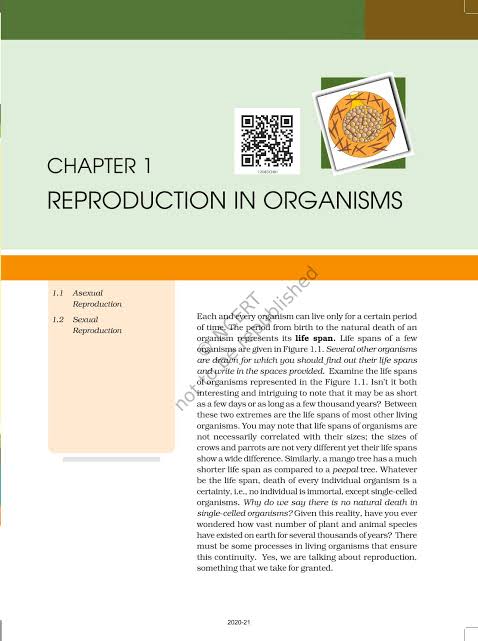Summary
The first chapter of Class 12 Biology, “Reproduction in Organisms,” provides an overview of the biological process of reproduction, which is essential for the continuation of species. The chapter covers the different modes of reproduction, such as asexual and sexual reproduction, and explains how these processes occur in various organisms, including plants, animals, and microorganisms. Key concepts include lifespan, reproductive phases, and events such as gametogenesis, fertilization, embryogenesis, and development. The chapter also emphasizes the importance of understanding reproduction for practical applications like agriculture, horticulture, and animal husbandry.

Class 12 Biology Chapter Reproduction in Organisms Book 📚 download PDF files 👇👇👇
Long and Short Questions and Answers:
Q: What is reproduction, and why is it essential?
A: Reproduction is the biological process by which new individual organisms are produced from their parents. It is essential for the continuation of a species and ensures the transfer of genetic information from one generation to the next.
Q: Differentiate between asexual and sexual reproduction.
A: Asexual reproduction involves a single parent and produces offspring genetically identical to the parent (clones). Sexual reproduction involves two parents, resulting in offspring with genetic variation.
Q: Define binary fission and name an organism that reproduces this way.
A: Binary fission is a type of asexual reproduction where a single organism divides into two equal halves, each becoming a new organism. Example: Amoeba.
Q: What is budding? Give an example of an organism that reproduces through budding.
A: Budding is an asexual reproduction method where a new organism develops from an outgrowth or bud due to cell division at one particular site. Example: Hydra.
Q: Explain vegetative propagation with an example.
A: Vegetative propagation is a form of asexual reproduction in plants where new plants are produced from roots, stems, leaves, or buds. Example: Potato tubers sprouting new plants.
Q: What is the difference between external and internal fertilization?
A: External fertilization occurs outside the body, usually in water (e.g., fish and amphibians), while internal fertilization occurs inside the female body (e.g., mammals).
Q: Describe the concept of a life span.
A: The life span is the period from birth to the natural death of an organism. It varies significantly among different species.
Q: What is parthenogenesis? Provide an example.
A: Parthenogenesis is a form of asexual reproduction where an egg develops into a complete organism without being fertilized. Example: Honeybee drones.
Q: What are the main phases of sexual reproduction in organisms?
A: The main phases of sexual reproduction are the pre-fertilization phase (gametogenesis), fertilization (syngamy), and post-fertilization (development and embryogenesis).
Q: What is gametogenesis?
A: Gametogenesis is the process by which gametes (sperm and egg cells) are produced in the reproductive organs.
Q: Define the term ’embryogenesis.’
A: Embryogenesis is the process by which the embryo forms and develops from the fertilized egg (zygote).
Q: What are monoecious and dioecious organisms?
A: Monoecious organisms have both male and female reproductive organs in the same individual (e.g., Earthworm), while dioecious organisms have separate sexes (e.g., Humans).
Q: Explain the significance of pollination in plants.
A: Pollination is the transfer of pollen from the male part of a flower (anther) to the female part (stigma), essential for fertilization and the production of seeds.
Q: What are the different types of asexual reproduction?
A: The main types include binary fission, budding, spore formation, fragmentation, and vegetative propagation.
Q: Describe spore formation in fungi.
A: Spore formation is an asexual reproduction method where the fungus produces spores, which are released into the environment and can grow into new individuals under favorable conditions.
Q: What is the role of mitosis in asexual reproduction?
A: Mitosis is the process of cell division that ensures the equal distribution of genetic material to the daughter cells, enabling the growth and reproduction of organisms through asexual means.
Q: Define fragmentation and give an example.
A: Fragmentation is a type of asexual reproduction where an organism breaks into fragments, each capable of growing into a new individual. Example: Spirogyra.
Q: What is the role of meiosis in sexual reproduction?
A: Meiosis is the process of cell division that reduces the chromosome number by half, leading to the formation of haploid gametes, which fuse during fertilization to restore the diploid state.
Q: Explain the concept of alternation of generations.
A: Alternation of generations is a reproductive cycle found in plants, where a diploid sporophyte generation alternates with a haploid gametophyte generation.
Q: What is the significance of genetic variation in sexual reproduction?
A: Genetic variation, resulting from the combination of different alleles during sexual reproduction, increases the adaptability of a species to changing environments.
Q: Define zygote and its role in reproduction.
A: A zygote is the cell formed by the fusion of male and female gametes during fertilization. It develops into an embryo and eventually into a new organism.
Q: What is the significance of vegetative propagation in agriculture?
A: Vegetative propagation allows for the production of genetically identical plants, enabling the cultivation of crops with desirable traits.
Q: What are the differences between gametes and spores?
A: Gametes are haploid cells involved in sexual reproduction, requiring fusion with another gamete. Spores are haploid cells involved in asexual reproduction, capable of developing into a new organism without fusion.
Q: What is a clone, and how is it produced?
A: A clone is an organism or cell produced asexually from a single parent, genetically identical to the parent. It is produced through processes like binary fission, budding, or vegetative propagation.
Q: Explain the concept of oogenesis and spermatogenesis.
A: Oogenesis is the formation of female gametes (ova) in the ovaries, while spermatogenesis is the formation of male gametes (sperm) in the testes.
Q: What is double fertilization, and in which organisms does it occur?
A: Double fertilization is a unique process in angiosperms where one sperm fertilizes the egg, forming a zygote, while the other sperm fuses with two polar nuclei to form the endosperm.
Q: Define the term ‘viviparous’ and give an example.
A: Viviparous organisms give birth to live young instead of laying eggs. Example: Humans.
Q: What is the role of pollen grains in reproduction?
A: Pollen grains carry the male gametes (sperm cells) in plants and are essential for the fertilization of the ovules in sexual reproduction.
Q: Explain the importance of fertilization in reproduction.
A: Fertilization is the process where male and female gametes fuse, restoring the diploid number of chromosomes and initiating the development of a new organism.
Q: Describe the significance of seed formation in flowering plants.
A: Seed formation ensures the survival and dispersal of the plant species. Seeds protect the embryo and provide a food source for its development during germination.

Get involved!
Comments